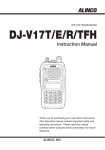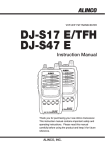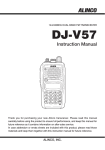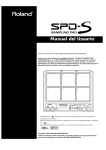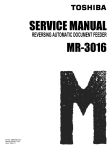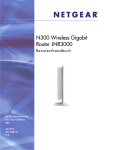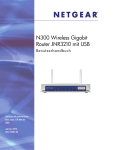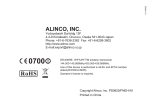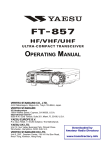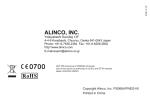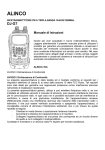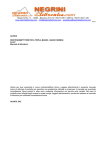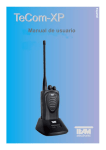Download Alinco DJ-596T Instruction manual
Transcript
VHF FM TRANSCEIVER DJ-175 T/E/TFH Instruction Manual Thank you for purchasing your new Alinco transceiver. This instruction manual contains important safety and operating instructions. Please read this manual carefully before using the product and keep it for future reference. ALINCO, INC. NOTICE / Compliance Information Statement NOTICE / Compliance Information Statement This equipment has been tested and found to comply with the limits for a Class B digital device, pursuant to part 15 of the FCC Rules. These limits are designed to provide reasonable protection against harmful interference in a residential installation. This equipment generates, uses, and can radiate radio frequency energy and, if not installed and used in accordance with the instruction manual, may cause harmful interference to radio communications. However, there is no guarantee that interference will not occur in a particular installation. If this equipment does cause harmful interference to radio or television reception, which can be determined by turning the equipment off and on, the user is encouraged to try to correct the interference by one or more of the following measures: • Reorient or relocate the receiving antenna. • Increase the separation between the equipment and receiver. • Connect the equipment into an outlet on a circuit different from that to which the receiver is connected. • Consult the dealer or an experienced radio/TV technician for help. Tested to Comply With FCC Standards FOR HOME OR OFFICE USE Information in this document is subject to change without notice or obligation. All brand names and trademarks are the property of their respective owners. Alinco cannot be liable for pictorial or typographical inaccuracies. Some parts, options and/or accessories are unavailable in certain areas. Changes or modifications not expressly approved by the party responsible for compliance could void the user's authority to operate the equipment. VHF FM Transceiver DJ-175T/E/TFH This device complies with Part 15 of the FCC Rules. Operation is subject to the following two conditions: (1) This device may not cause harmful interference, and (2) this device must accept any interference received, including interference that may cause undesired operation. Manufacturer: ALINCO, Inc. Yodoyabashi Dai-bldg. 13F 4-4-9 Koraibashi, Chuo-ku, Osaka 541-0043 Japan 2 NOTICE / Compliance Information Statement Conformity Information Alinco, Inc. Electronics Division hereby declare on our sole responsibility that the product(s) listed below comply the essential requirements of the Directive 1999/5/EC, The council of 3/9/99 on Radio Equipment and Telecommunication Terminal Equipment and the mutual recognition of their conformity and with the provisions of Annex, after having performed the required measurements at Notified Bodies per Standards, and relative certificate(s) or document(s) can be reviewed at http://www. alinco. com/Ce/ DJ-175E: VHF FM Transceiver 144.000~145.995MHz 0560 This device is authorized for use in all EU and EFTA member states. An operator's license is required for this device. Copyright © All rights reserved. No part of this document may be reproduced, copied, translated or transcribed in any form or by any means without the prior written permission of Alinco. Inc., Osaka, Japan. English edition Printed in Japan. 3 Warning Warning To prevent any hazard during operation of Alinco's radio product, in this manual and on the product you may find symbols shown below. Please read and understand the meanings of these symbols before starting to use the product. d Danger d Alert d Caution d a m This symbol is intended to alert the user to an immediate danger that may cause loss of life and property if the user disregards the warning. This symbol is intended to alert the user to a possible hazard that may cause loss of life and property if the user disregards the warning. This symbol is intended to alert the user to a possible hazard that may cause loss of property or injure the user if the warning is disregarded. Alert symbol. An explanation is given. Warning symbol. An explanation is given. Instruction symbol. An explanation is given. d Alert ■ Environment and condition of use It is recommended that you check local traffic regulations regarding the use of radio equipment while driving. Some countries prohibit or apply restrictions for the operation of radios and mobile- phones while driving. a j especially medical ones. It may cause interference to those devices. a Keep the radio out of the reach of children. In case a liquid leaks from the product, do not touch it. It may damage your j skin. Rinse with plenty of cold water if the liquid contacted your skin. Never operate this product in facilities where radio products are prohibited for j use such as aboard aircraft, in airports, in ports, within or near the operating Do not use this product in close proximity to other electronic devices, area of business wireless stations or their relay stations. j informed in advance when you travel. The manufacturer declines any responsibilities against loss of life and/or a property due to a failure of this product when used to perform important tasks Use of this product may be prohibited or illegal outside of your country. Be like life-guarding, surveillance, and rescue. 4 Warning j and/or damage to the product(s). Risk of explosion if battery is replaced with an incorrect type. a Dispose of, or recycle used batteries according to your local regulations. The manufacturer declines any responsibilities against loss of life and property due to a a failure of this product when used with or as a part of a device made by third parties. Use of third party accessory may result in damage to this product. It will void a our warranty for repair. Do not use multiple radios in very close proximity. It may cause interference ■ Handling this product Be sure to reduce the audio output level to minimum before using an earphone or a headset. Excessive audio may damage hearing. a Do not open the unit without permission or instruction from the manufacturer. m Unauthorized modification or repair may result in electric shock, fire and/or malfunction. l in electric shock, fire and/or malfunction. Do not place the product in a container carrying conductive materials, such as j water or metal in close proximity to the product. A short-circuit to the product Do not operate this product in a wet place such as shower room. It may result may result in electric shock, fire and/or malfunction. ■ About chargers Do not use adapters other than having the specified voltage. It may result in electric shock, fire and/or malfunction. j Do not plug multiple devices using an adapter into a single wall outlet. It may j result in overheating and/or fire. j Do not handle adapter with a wet hand. It may result in electric shock. Securely plug the adapter into the wall outlet. Insecure installation may result a in short-circuit, electronic shock and/or fire. Do not use the adapter if the plug or socket contacts are dirty. Overheating and/or j short-circuiting may result in fire, electric shock and/or damage to the product. ■ About power supply j Use only appropriate, reliable power supply of correct voltage and capacity. Do not connect cables in reverse polarity. It may result in electric shock, fire j and/or malfunction. Do not plug multiple devices including the power supply into a single wall j outlet. It may result in overheating and/or fire. 5 Warning j Do not handle a power supply with a wet hand. It may result in electric shock. Securely plug the power supply to the wall outlet. Insecure installation may a result in short-circuiting, electronic shock and/or fire. Do not plug the power supply into the wall socket if the contacts are dirty. j Short-circuit and/or overheating may result in fire, electric shock and/or damage to the product. j fire, electric shock and/or damage to the product. Do not modify or remove fuse-assembly from the DC cable. It may result in ■ Cigar-lighter cable Do not use the cable at any other than the specified voltage. It may result in electric shock, fire and/or malfunction. j j Do not handle cigar cable with a wet hand. It may result in electric shock. ■ In case of emergency In case of the following situation(s), please turn off the product, switch off the source of power, then remove or unplug the power-cord. Please contact your local dealer of this product for service and assistance. Do not use the product until the trouble is resolved. Do not try to troubleshoot the problem by yourself. • When a strange sound, smoke and/or strange odor comes out of the product. • When the product is dropped or the case is broken or cracked. • When a liquid penetrated inside. • When a power cord (including DC cables, AC cables and adapters) is damaged. a accessories from the wall outlet if a thunderstorm is likely. For your safety, turn off then remove all related AC lines to the product and its ■ Maintenance Do not open the unit and its accessories. Please consult with your local dealer of this product for service and assistance. m 6 Warning d Caution ■ Environment and condition of use Do not use the product in proximity to a TV or a radio. It may cause interference or receive interference. j Do not install in a humid, dusty or insufficiently ventilated place. It may result j in electric shock, fire and/or malfunction. Do not install in an unstable or vibrating position. It may result in electric j shock, fire and/or malfunction when/if the product falls to the ground. Do not install the product in proximity to a source of heat and humidity such as j a heater or a stove. Avoid placing the unit in direct sunlight. Be cautious of a dew formation. Please completely dry the product before use j when it happens. ■ About transceiver Be cautious of the whip antenna when carried in your shirt-pocket etc. It may make contact with your eye and cause injury. a Do not connect devices other than specified ones to the jacks and ports on the j product. It may result in damage to the devices. Turn off and remove the battery from the product when the product is not in use a for extended period of time or in case of maintenance. j Never pull the cord alone when you unplug AC cable form the wall outlet. Use a clean, dry cloth to wipe off dirt and condensation from the surface of the a product. Never use thinner or benzene for cleaning. ■ About power supply Use only reliable power supply of specific DC output range and be mindful of the polarity of the cable and DC-jack. a When using an external antenna, make sure that the antenna ground is not a common with the ground of the power supply. When a charger is powered from an external DC power source (adapter, power a supply, cigar-plug etc), make sure that this power supply has approved to the level of IEC/EN 60950-1. 7 Warning ■ Lightning Any person is not safe outdoor during thunderstorm and lightning. This condition is getting worse if somebody keeps a hand-held radio; chances of being hit by lightning are doubled since lightning may hit a radio antenna as well. At this time, there is no handheld radio having any kind of protection against lightning current (which is higher than 10 kA.). Note also that no car provides adequate protection of its passengers or drivers against lightning as well. Therefore, Alinco will not take responsibility for any danger associated with using its hand-held radios outdoor or inside the car during lightning. ■ Limited Power Source Adhering to the requirement of the following warning ensures compliance of the transceiver with the safety standard for information technology equipment, EN 609501. Please note that the transceiver enclosure only provides mechanical protection of its internal parts; it will not contain a fire within the device if the fire starts under certain fault conditions. Alinco will not take responsibility for any fire hazard associated with powering the transceiver or charging its batteries using a power source which does not belong to the limited power sources in the meaning of EN 60950-1. 8 Introduction Introduction Thank you very much for purchasing this excellent Alinco transceiver. Our products are ranked among the finest in the world. This radio has been manufactured with state of the art technology and it has been tested carefully at our factory. It is designed to operate to your satisfaction for many years under normal use. PLEASE READ THIS MANUAL COMPLETELY TO LEARN ALL THE FUNCTIONS THE PRODUCT OFFERS. WE MADE EVERY ATTEMPT TO WRITE THIS MANUAL TO BE AS COMPREHENSIVE AND EASY TO UNDERSTAND AS POSSIBLE. IT IS IMPORTANT TO NOTE THAT SOME OF THE OPERATIONS MAY BE EXPLAINED IN RELATION TO INFORMATION IN PREVIOUS CHAPTERS. BY READING JUST ONE PART OF THE MANUAL, YOU RISK NOT UNDERSTANDING THE COMPLETE EXPLANATION OF THE FUNCTION. *In case addendum sheet(s) is inserted to the package of this product, please read it and keep it together with the instruction manual for your future reference. 9 Contents Contents NOTICE / Compliance Information Statement ................................................2 Warning...............................................................................................................4 Introduction ........................................................................................................9 Contents ...........................................................................................................10 1.Features .........................................................................................................13 1.1 Accessories .........................................................................................................13 2.Accessories ...................................................................................................14 2.1 Installations .........................................................................................................14 2.1.1 Antenna ......................................................................................................14 2.1.2 Hand Strap..................................................................................................14 2.1.3 Belt Clip .....................................................................................................15 2.1.4 Battery Pack ...............................................................................................15 2.1.5 Prevent Short Circuiting the Battery Pack .................................................17 2.1.6 Battery-Level Icon......................................................................................17 3.Names and Operations of Parts ..................................................................18 3.1 Names and Operations of Keys and Ports...........................................................18 3.2 Keypad ................................................................................................................20 3.3 Display (LCD) ....................................................................................................21 4.Basic Operation ............................................................................................22 4.1 Turning On the Power.........................................................................................22 4.2 Adjusting the Audio Output (Volume) ...............................................................22 4.3 Adjusting the Squelch .........................................................................................22 4.4 Setting the Frequency in the VFO Mode ............................................................23 4.4.1 Setting the Frequency.................................................................................23 4.4.2 Setting the Tuning Step ..............................................................................24 4.4.3 Shift Direction and Offset Frequency Settings...........................................24 4.5 Memory Mode ....................................................................................................25 4.5.1 How to Program Memory Channel(s) ........................................................25 4.5.2 Recalling a Memory Channel.....................................................................26 4.5.3 Deleting a Memory Channel ......................................................................26 4.5.4 Programming a Repeater-Access Function Setting....................................26 4.5.5 Programmable Parameters in Memory Channels.......................................27 4.6 Call-Channel Mode.............................................................................................27 10 Contents 4.7 Receiving ............................................................................................................28 4.7.1 Monitor Function........................................................................................28 4.8 Transmitting .......................................................................................................28 4.8.1 Selecting the Output Level .........................................................................29 5.Useful Functions ...........................................................................................30 5.1 Scan Modes.........................................................................................................30 5.1.1 VFO-Scan...................................................................................................30 5.1.2 Memory-Scan .............................................................................................30 5.1.3 Setting Skip Channels ................................................................................31 5.2 Keylock ...............................................................................................................31 5.3 Tone-Burst ..........................................................................................................31 5.4 Naming Memory Channels .................................................................................32 5.4.1 Setting Name-Tag.......................................................................................32 5.4.2 Using the Channel Name Function ............................................................32 5.5 Auto-Power-Off (APO) ......................................................................................33 5.5.1 Setting APO................................................................................................33 5.5.2 APO Operation ...........................................................................................33 5.6 Time-Out-Timer (TOT) ......................................................................................33 5.6.1 Setting TOT................................................................................................33 5.6.2 TOT Operation ...........................................................................................33 5.7 Lamp ..................................................................................................................34 6.Selective Calling............................................................................................35 ■ Selective Calling Operations ...................................................................................35 6.1 Tone Squelch (TSQ) ...........................................................................................35 6.1.1 Setting the Tone Squelch............................................................................35 6.1.2 Switching Off the Tone Squelch ................................................................36 6.1.3 To Differentiate the ENC/DEC Tones .......................................................36 6.1.4 Tone Squelch Operation.............................................................................36 6.2 DCS ....................................................................................................................36 6.2.1 Setting the DCS ..........................................................................................36 6.2.2 Changing the DCS Code ............................................................................37 6.2.3 Switching Off DCS ....................................................................................37 6.2.4 DCS Operation ...........................................................................................37 6.2.5 DET Mode in DCS Operation ....................................................................37 6.3 DTMF Tone Encoding........................................................................................38 6.4 Auto Dialer .........................................................................................................38 6.4.1 Setting the Auto Dialer...............................................................................38 6.4.2 Generating the Auto Dialer Codes .............................................................39 6.4.3 Redial..........................................................................................................39 11 Contents 7.Special Functions..........................................................................................40 7.1 Battery Refresh ...................................................................................................40 7.2 Repeater-Access..................................................................................................40 8.Set Mode........................................................................................................41 8.1 Set Mode Operation ............................................................................................41 8.2 Entering the Set Mode ........................................................................................41 8.3 Available Parameters ..........................................................................................42 8.3.1 Menu 1 Battery Save (BS) Function ..........................................................42 8.3.2 Menu 2 Timer/Busy Scan Setting ..............................................................42 8.3.3 Menu 3 Beep Function ...............................................................................42 8.3.4 Menu 4 Tone-Burst Frequency Setting ......................................................42 8.3.5 Menu 5 Clock Shift Setting ........................................................................43 8.3.6 Menu 6 Busy Channel Lockout Setting .....................................................43 8.3.7 Menu 7 TOT Penalty Time ........................................................................44 8.3.8 Menu 8 DTMF WAIT Time.......................................................................44 8.3.9 Menu 9 DTMF Burst/Pause Time ..............................................................44 8.3.10 Menu 10 DTMF First Digit Burst Time.....................................................45 8.3.11 Menu 11 Battery Type Setting ...................................................................46 9.Cloning and Packet Operation ....................................................................47 9.1 Cloning................................................................................................................47 9.1.1 Cable Connection .......................................................................................47 9.1.2 Master/Slave Units .....................................................................................47 9.1.3 Master Unit Operation................................................................................48 9.1.4 Slave Unit Operation ..................................................................................48 9.2 Packet Operation.................................................................................................49 9.2.1 Packet Operation Connections ...................................................................49 10.Maintenance and Reference......................................................................50 10.1 Troubleshooting ..................................................................................................50 10.2 Resetting .............................................................................................................51 10.2.1 All Resetting...............................................................................................51 10.2.2 Partial Resetting .........................................................................................51 10.3 Options................................................................................................................52 10.3.1 Battery Packs..............................................................................................52 10.3.2 Using the Chargers .....................................................................................53 11.Specifications .............................................................................................56 12 1.Features 1. Features This transceiver has the following main features. ■ 39 CTCSS tone squelch ■ 104 DCS digital code squelch ■ Time-Out-Timer ■ Alphanumeric display ■ 4 tone-burst tones (1750, 2100, 1000, 1450Hz) ■ 9 auto dial memories easily accessed from the DTMF keypad with 1 redial function ■ Direct frequency entry from the DTMF keypad ■ A quick "Repeater-Access" function ■ Refresh function for rechargeable battery reconditioning ■ Cable Cloning ■ 3 levels of output power (5/2/0.5W) ■ 200 memories plus 1 CALL channel 1.1 Accessories • EBP-72 Ni-MH battery pack (7.2V 700mAh) • EDC-165 Trickle battery charger • EA0141 Flexible whip antenna (T/E version) • EA0142 Flexible whip antenna (TFH version) • EDC-146 (AC 120V) AC adapter (T version) • EDC-147 (AC 230V) AC adapter (E/TFH version) • EDC-148 (AC 230V) AC adapter (U.K. models) • Belt clip • Hand strap • Instruction manual NOTE: Accessories may differ depending on the version you have purchased. Please contact your local dealer for details of standard accessories and the warranty-policy. 13 2.Accessories 2. Accessories 2.1 Installations 2 2.1.1 Antenna ■ Attaching the Antenna 1. Hold the antenna by its base. 2. Align the grooves at the base of the antenna with the protrusions on the antenna connector. 3. Slide the antenna down and turn it clockwise until it stops. 4. Confirm that the antenna is securely connected. NOTE: This antenna has been designed very flexible. It is softer than conventional ones but not a defect. ■ Removing the Antenna Turn the antenna counter-clockwise to disconnect. 2.1.2 Hand Strap Attach the hand strap to the belt clip as shown in the illustration. Belt clip Hand strap 14 2.Accessories 2.1.3 Belt Clip ■ Attaching the Belt Clip Attach the belt clip to the back of the transceiver until it clicks. Belt clip Catch 2 ■ Removing the Belt Clip Push up the catch of the belt clip, and pull it. Belt clip Catch 2.1.4 Battery Pack For the specifications and the charging procedures, please refer to "Battery Packs"(page 52) and "Using the Chargers"(page 53). ■ Attaching the Battery Pack Align the catches on the transceiver with the grooves on the battery pack, and slide the battery pack in the direction of the arrow until it clicks. Catches ■ Removing the Battery Pack Push up the catch on the battery pack, and pull it or free of the transceiver. Catch 15 2.Accessories Caution 2 16 • The battery pack isn't fully charged when shipped. It must be charged before use. • Charging should be conducted in a temperature range of 0ºC to +40ºC (+32ºF to +104ºF). • Don't modify, dismantle, incinerate or immerse the battery pack in the water as this can be dangerous. • Never short-circuit the battery pack terminals, as this can cause damage to the equipment or lead to heating of the battery which may cause burns. • Unnecessary prolonged charging (overcharging) can deteriorate battery performance. • The battery pack should be stored in a dry place where temperature is in -10ºC to +45ºC (-14ºF to +113ºF) range. Temperatures outside this range can cause the battery liquid to leak. Exposure to prolonged high humidity can cause corrosion of metal components. • Battery-packs are a consuming part. When its operating time becomes considerably short after a normal charge, please consider that the pack is exhausted and replace it with a new one. • The battery pack is recyclable. Check with your local waste officials for details on recycling options or proper disposal in your area. • Risk of explosion, generation of heat or leak of chemicals inside if the battery is replaced by an incorrect type. Use always the recommended types of batteries in this manual only • Use specified genuine chargers only to charge battery packs. Use of other chargers may cause damage to products, you and your property. 2.Accessories 2.1.5 Prevent Short Circuiting the Battery Pack Be extra cautious when carrying the rechargeable battery pack; short circuiting will produce surge current possibly resulting in fire. 2 DON'T carry with metals of any type, e.g. chains. DON'T carry the battery pack inside bags made of conductive materials. Do enclose inside a non-conductive enclosure. (bags or handkerchief made only of non-conductive material) DON'T place in the proximity of metals or conductives, e.g. nails, chains. Do protect by spreading a non-conductive sheet on a flat surface. 2.1.6 Battery-Level Icon During the operation, a black battery icon indicates that the battery-level is in usable range. When it turns to empty, please charge the pack or replace the cells with new ones. Battery-level icon The battery is in usable condition. Battery-level is low. Replace or charge the pack. 17 3.Names and Operations of Parts 3. Names and Operations of Parts 3.1 Names and Operations of Keys and Ports 3 ⑪ ⑫ ① ② ③ ④ ⑤ ⑦ ⑧ ⑥ ⑨ ⑩ 18 3.Names and Operations of Parts ① SMA Antenna Connector ② PTT key ③ Speaker ④ Microphone ⑤ TX/RX lamp ⑥ Display (LCD) ⑦ FUNC key ⑧ MONI key ⑨ Power key ⑩ Keypad ⑪ Microphone/ Speaker jack ⑫ Dial Attach the whip antenna. If you plan to use an optional antenna, select one that is tuned to the operating frequency. Press the PTT key to transmit, release to receive. A speaker is built in. Speak into the microphone from a distance of about 5cm (2"). Lights green when the squelch is unmuted. Lights red during transmission. Refer to "Display" (page 21). The FUNC key is used in combination with the other keys to access the various functions of the unit. To enter the Set mode to set operating parameters, press the FUNC key continuously for about 2 seconds. When the MONI key is pressed, the squelch unmutes regardless of the TSQ/DCS setting. Pressing the MONI key after pressing the FUNC key illuminates display for about 5 seconds. Pressing the MONI key while pressing the PTT key transmits a tone-burst signal. Press the power key down for approximately one second to turn on/off the unit. Refer to "Keypad" (page 20). For an optional speaker/Mic connection. 3 Rotate the dial to select the frequency of operation, memory channel, offset frequency, tone frequency, DCS code, Set mode settings, and the characters for name-tags. Rotating the dial while pressing the FUNC key increases or decreases the frequency in 1MHz order. 19 3.Names and Operations of Parts 3.2 Keypad 3 key Without pressing the FUNC key. While appears after the FUNC key is pressed. Inputs* 1. Channel step setting (page 24). Inputs 2. Offset frequency setting (page 24). Inputs 3. Time-Out-Timer setting (page 33). Inputs 4. Tone Encode/Tone Squelch setting (page 35). Inputs 5. Hi/Mid/Low power setting (page 29). Inputs 6. Auto-Power-Off setting (page 33). Inputs 7. DCS (digital code squelch) setting (page 36). Inputs 8. Repeater-Access function setting (page 40). Inputs 9. Auto dialer memory setting (page 38). Inputs 0. N/A Switches between the VFO and Memory programming (page 25). Memory mode (page 23). Start/Stop scanning (page 30). Key/Frequency lock setting (page 31). Access the Call channel (page 27). Memory channel skip setting (page 31). Auto dialer operation (page 38). Naming memory channels setting (page 32). SQL adjustment (page 22). N/A Audio level adjustment (page 22). N/A * The numeric keys can be used for direct VFO frequency input within the product's operating range. DTMF tones are generated by pressing the keys during transmissions. 20 3.Names and Operations of Parts 3.3 Display (LCD) ① ②③④ ⑤ ⑥ ⑦ ⑧ ⑨ ⑩ ⑪ ⑫ 3 ⑬ ⑭⑮ ⑯ ⑰ ① Appears when the FUNC key is pressed. ② Indicates the shift (+/-) direction. ③ Appears when setting the CTCSS tone encoder. ④ Appears when setting the tone squelch. ⑤ Appears when setting the DCS. ⑥ Displays the frequency and scan operation. ⑦ Displayed when the frequency or the keypad is locked. ⑧ Appears when the Repeater-Access function is activated. ⑨ Appears when Auto-Power-Off function is activated. ⑩ / Indicates battery-level. The black icon flashes when the battery charge function is on. ⑪ Displayed when in the Memory mode. ⑫ Displays the memory channel No. ⑬ Displayed when the transmission output is in LOW setting. ⑭ Displayed when the transmission output is in MID setting. ⑮ Displays the operating frequencies, name-tags and parameters in the setting mode. ⑯ Appears when the squelch is unmuted. ⑰ Indicates the receiving signal (S-meter) and transmission output levels (Power-meter). 21 4.Basic Operation 4. Basic Operation 4.1 Turning On the Power Hold the key down for a second. To turn off the power, hold the the display turns off. 4 key down until 4.2 Adjusting the Audio Output (Volume) • There are 21 audio output levels (00~20). • The default setting is level 00. There is no audio output at this status. 1. Press the key. The level is displayed on the LCD. 2. Rotate the dial to increase or decrease the level. As the setting value increases, the audio becomes louder. 3. Press any key except for the MONI key or just leave it for 5 seconds to automatically complete the setting. 4.3 Adjusting the Squelch Squelch is a function that eliminates the noise when no signals are being received. • There are 11 squelch levels (00~10). • The default setting is Level 00. 1. Press the key. The squelch level is displayed on the LCD. 2. Rotate the dial to increase or decrease the squelch level. Set to the lowest level that the noise is cut. 3. Press any key except for the MONI key or just leave it for 5 seconds to automatically complete the setting. 22 4.Basic Operation 4.4 Setting the Frequency in the VFO Mode The factory default of this unit is the VFO mode. The VFO mode allows you to change the frequency and operating parameters by using the dial and key operations. 4.4.1 Setting the Frequency ■ To Select the VFO Mode The key switches between the VFO and Memory mode each time the key is pressed. " " is displayed on the LCD when the unit is in the Memory mode. ■ Selecting the Operating Frequency Rotate the dial clockwise to increase the frequency by one tuning step. Rotate the dial counter-clockwise to decrease it by one tuning step. 4 ■ To Quickly Change the Frequency Press the FUNC key, and while is displayed on the screen, rotate the dial to increase or decrease (depending on the direction of rotation) the frequency by 1MHz order. ■ Entry from the Keypad Use the numeric keys to set the frequency. It accepts valid numbers only. ie: 145.210 MHz 1. Input the 100MHz digit by pressing 2. Input the 10MHz digit by pressing 3. Input the 1MHz digit by pressing 4. Input the 100kHz digit by pressing 5. Input the 10kHz digit by pressing 6. Input the 1kHz digit by pressing Depending on the tuning step, entry may be required to the 1kHz digit. The relationship between the tuning step and entry-completion digit is shown in the following chart. The setting will be completed automatically when the last digit is correctly entered and a high-tone beep sounds. 23 4.Basic Operation Tuning step 5.0kHz 10.0kHz 12.5kHz 15.0kHz 20kHz 25kHz 30kHz Entry completion digit Final digit selection 1kHz Accept 0 or 5 as valid number. Accept any of 0 to 9 keys. 10kHz 10kHz When you input the 10kHz digit, the 1kHz digit is set automatically as follows. 0---00.0, 1---12.5, 2---25.0, 3---37.5, 4---invalid, 5---50.0, 6---62.5, 7---75.0, 8---87.5, 9---invalid Accept 0 or 5 as valid number. 1kHz Auto-complete after the 10kHz digit entry. 10kHz When you input the 10kHz digit, the 1kHz digit is 10kHz set automatically as follows. 0---00.0, 2---25.0, 5---50.0, 7---75.0 Other entries are invalid. Auto-complete after the 10kHz digit entry. 10kHz 4 4.4.2 Setting the Tuning Step 1. Press the FUNC key in the VFO mode, and while key to display the current tuning step. is displayed, press the 2. Rotate the dial to select the desired tuning step. DOWN STP-5 STP-10 STP-12.5 UP STP-15 STP-20 (unit: kHz) STP-25 STP-30 3. Press any key except for the MONI key to complete setting. NOTE: • Tuning step can't be changed in the Memory mode. • When the tuning step is changed from 5kHz,10kHz,15kHz,20kHz or 30kHz to 12.5kHz and 25kHz or vice versa, the operating frequency and the shift width automatically suit to the new setting. 4.4.3 Shift Direction and Offset Frequency Settings In conventional repeater systems, a signal received on one frequency is retransmitted on another frequency. The difference between these two frequencies is called the offset frequency. The selectable offset frequency of this unit is from 0 to 99.995MHz. 1. Press the FUNC key, and while is displayed, press the key to display the current offset frequency and shift direction settings. 24 4.Basic Operation 2. Each time the key is pressed the shift direction changes as indicated below. A (-) means that the TX frequency is lower than the RX frequency. A (+) means vice versa. -0.600 +0.600 OST-OF 3. Rotate the dial while the shift frequency is being displayed. Clockwise: each click increases the frequency by one tuning step. Counter-clockwise: each click decreases the frequency by one tuning step. Press the FUNC key and rotate the dial to increase or decrease the frequency in 1MHz steps. 4. Press any key except for the MONI or FUNC key to complete setting. 4 NOTE: • Please refer to "Selective Calling" (page 35) to set the CTCSS/DCS tones usually required for conventional Repeater-Accesses. • If the offset frequency is set to exceed the transmitting frequency range of this unit, "OFF" appears on the display and a beep sounds when the PTT key is pressed. You can not transmit in this state. 4.5 Memory Mode This mode allows recalling and operating the preprogrammed frequency or setting in the memory channels. This unit provides up to 200 memory channels, 1 CALL channel and 1 Repeater-Access function memory. 4.5.1 How to Program Memory Channel(s) 1. Select a frequency and operating parameters to be programmed in the VFO mode. Programmable parameters are explained later. Press the key. " " appears on the display. 2. Press the FUNC key to display . 3. Rotate the main dial to select the desired memory channel number while is displayed. An empty channel is shown with a flashing " ". Select C for CALL channel programming. "rP ALLFREQ" is explained later. 4. By pressing the key again while programming is completed. is on the display, a beep sounds and 5. Pressing the FUNC then key while is displayed on the programmed channel will delete the memory data and it becomes available for reprogramming. 25 4.Basic Operation 4.5.2 Recalling a Memory Channel 1. Select the Memory mode by pressing the key. " " and channel number appear on the display to indicate that the unit is in the Memory mode. Repeat to switch between the Memory and VFO modes. 2. Select a memory channel. Rotating the main dial will increase or decrease a memory channel number. 4.5.3 Deleting a Memory Channel 1. Select the Memory mode by pressing the key. 2. Rotate the dial to select the memory channel No. that you wish to delete. 4 3. Press the FUNC key, and while is displayed on the LCD, press the beep sounds, then " " flashes on the display. key. A NOTE: When " " is flashing in step 3 (when the memory contents are displayed as is on the display), it is still possible to cancel the operation by pressing the FUNC key, and while is displayed on the LCD, press the key. After changing channels or modes, this is no longer possible. 4.5.4 Programming a Repeater-Access Function Setting The "Repeater-Access" function is to set the desired shift and tone parameters to the current operating frequency by just 2 key-touches. Please set the parameters to be applied to the Repeater-Access function here. 1. Enter the Memory mode (by pressing the key if necessary). 2. Rotate the dial to select MrpALLFRQ. 3. Set the most commonly used Repeater-Access parameters by referring to "RepeaterAccess" (page 40). The parameters that can be programmed in this memory are marked * in the chart 4.5.5 on the next page. By activating the Repeater-Access function these settings are applied to the operating frequency regardless of the VFO/Memory/CALL modes, by temporary replacing the current parameters. 4. After programming is completed, press the FUNC key then press the while MrpALL is displayed to store the edited parameters. key 5. Rotate the dial to operate in the Memory mode by selecting channels or press the key for VFO mode operation. NOTE: • You can not communicate in the channel. • The channel is skipped during scanning. You can not delete or convert this memory to other purposes. 26 4.Basic Operation 4.5.5 Programmable Parameters in Memory Channels The following parameters can be stored in each of the memory channels. • Frequency • Offset frequency * • Skip channel setting • Shift direction (+/-) * • Busy channel lockout (BCLO) • Tone encoder frequency * • Transmission power (H/M/L) • Tone decoder frequency * • Battery save setting • Tone encoder/decoder setting (TSQ) * • Clock Shift setting • DCS code * • Alphanumeric channel tag • DCS setting * NOTE: Only parameters marked "*" are programmable in Repeater-Access function memory. 4 4.6 Call-Channel Mode This mode is used to recall a most frequently used memory channel (stored in MC channel) with a single key-touch. 1. Press the key. " " is displayed on the LCD, and the channel programmed in MC is recalled. 2. Press the key again or the key in the Call mode to return to original operating mode (VFO/memory). IMPORTANT NOTE: • The dial and direct key-entry of frequency/memory channel are blocked in the Call mode. • It is possible to temporary change the offset and CTCSS/DCS related parameters in the Call mode. • The Scan function is deactivated in the Call mode. • The CALL channel reprogramming is possible but it can't be deleted from the memory channel mode. 27 4.Basic Operation 4.7 Receiving 1. Turn on the unit. 2. Press the key and rotate the dial to adjust the audio level as necessary. 3. Press the key and rotate the dial to adjust the squelch level. 4. Select the frequency that you wish to operate by using the dial or the keypad. When a signal is received on the frequency that you selected, and S-meter are displayed on the LCD, then the received signal can be heard. The green RX indicator also lights at this time. 4 4.7.1 Monitor Function In case the receiving signal is weak and the audio is intermittently cut off by the squelch, press the MONI key. As long as this key is pressed, the squelch including TSQ/DCS unmutes making the audio easier to hear. • The squelch is unmuted while the MONI key is pressed, regardless of the squelch level setting. • This function unmutes the squelch even if the DCS and Tone Squelch functions are set. 4.8 Transmitting 1. Select the frequency that you wish by using the dial or keypad. 2. Press the PTT key. The red TX indicator turns on while transmitting. 3. While holding down the PTT key, speak into the unit at normal voice from the distance of 5cm (2"). 4. Release the PTT key to receive. IMPORTANT NOTE: • To transmit a tone-burst signal, press the MONI key while holding down the PTT key. • Speaking too loud, too close or too far from the unit may distort the audio. • "OFF" appears on the display and a beep sounds when the PTT key is pressed with the TX frequency set out of the TX range. You can not transmit in this state. 28 4.Basic Operation 4.8.1 Selecting the Output Level Press the FUNC key, and while is displayed on the LCD, press the key to switch transmission power output. The display changes as follows depending on the output level selected: • is displayed with on the power meter. (Low power output) • is displayed with on the power meter. (Middle power output) • Nothing is displayed with on the power meter. (High power output) The initial setting is low power. IMPORTANT NOTE: The output level can't be altered while transmitting. 4 29 5.Useful Functions 5. Useful Functions 5.1 Scan Modes The scan function automatically searches the receiving signals. There are 2 modes for scan-resume condition. • Busy Scan: The scan stops when a signal is detected, stays until the signal is gone then resumes scanning. • Timer Scan: The scan stops when a signal is detected, and resumes scanning after 5 seconds regardless of receiving status. During scanning, the 1MHz decimal point ( ) on the frequency display flashes. Press any key other than the MONI key to stop scanning. Scanning starts in the direction of the last dial operation (up or down). 5 NOTE: Please refer to the Set mode to switch the setting between Timer and Busy scan modes (page 42). 5.1.1 VFO-Scan 1. Use the 2. Press the of one step. key to select the VFO mode. key to start scanning. The unit scans in accordance with the order 3. Rotate the dial clockwise/counter-clockwise to change the scan direction. VFO-scan scans the entire frequency range. 4. Press any key other than the MONI key to stop scanning. 5.1.2 Memory-Scan 1. Use the key to select the Memory mode. 2. Press the key to start memory scanning. 3. Rotate the dial clockwise/counter-clockwise to change the scan direction. Memory-scan scans all programmed memory channels. 4. Press any key other than the MONI key to stop scanning. NOTE: Please set the squelch level correctly before scanning, even in the TSQ scanning the normal squelch level adjustment is required to activate this function. 30 5.Useful Functions 5.1.3 Setting Skip Channels You can select the memory channels that you wish to skip during the memory-scan. • Press the FUNC key in the Memory mode, and while is displayed, press the key to set the currently selected memory channel as a skip channel. Use the same procedure to clear the skip channel setting. • The 10MHz decimal point appears for memory channels that are set as skip channels. NOTE: The Call channel and Repeater-Access memory are automatically skipped during scanning. 5.2 Keylock Press the FUNC key, and while is displayed, press the key to set the Keylock function on, and repeat the same to quit. When the Keylock is on, the is displayed on the LCD. When the Keylock is on, other than the following, all operations are blocked. * PTT * LAMP * MONI * VOL * SQL * Tone-burst * POWER ON/OFF * DTMF tone 5 NOTE: Keylock function can't be activated on the Repeater-Access function memory channel. 5.3 Tone-Burst This function is to generate an audible tone to access European repeaters mostly used in Europe. • To output the tone-burst tone, press the MONI key while holding down the PTT key. The tone is transmitted as long as the MONI key is pressed. The initial setting for the tone-burst tone is 1750Hz, but this can be changed in the Set mode (page 42). • While transmitting the tone-burst tone, the CTCSS/DCS tone is temporary suspended. 31 5.Useful Functions 5.4 Naming Memory Channels In the Memory mode, it is possible to display up to 6 alphanumeric characters (Nametag) instead of conventional frequency display. 5.4.1 Setting Name-Tag 1. Select the memory channel. 2. Press the FUNC key, and while is displayed press the key. 3. [A ] flashes on the display. 4. Rotate the dial to select a character to be the first digit. 5. Press the flashing. 5 key to input the next character. The previous character will stop 6. Repeat the same sequence as necessary. Press the key during setting to delete all characters. 7. Press any key (except MONI, , ) to complete the setting. 5.4.2 Using the Channel Name Function • Programmed memory channels are displayed with alphanumeric characters. The channel number is displayed as it normally is. • Press the FUNC key to display the frequency display for 5 seconds. Pressing certain keys during this 5 sec period may immediately recall the alphanumeric display, while other keys access their allocated functions. 32 5.Useful Functions 5.5 Auto-Power-Off (APO) This function prevents an useless battery consumption. 5.5.1 Setting APO Press the FUNC key, and while is displayed on the LCD, press the key. is displayed on the LCD, and the Auto-Power-Off function is set. Repeat the same to turn it off. • The initial setting for the APO function is off. 5.5.2 APO Operation • After having activated the APO and about 30 minutes elapse without any key-operation, the unit turns off automatically alerting with beep sounds. The time to Auto-Power-Off is determined by the last key operation only, not the last signal received. 5 5.6 Time-Out-Timer (TOT) This function automatically stops transmission when a preset time is elapsed. 5.6.1 Setting TOT 1. Press the FUNC key, and while OFF is displayed on the LCD. is displayed on the LCD, press the key. T- 2. Rotate the dial to change the TOT setting time. The maximum setting for the TOT time is 450 seconds. OFF 30 60 90 ------ 450 (unit: seconds) 3. Press any key other than the MONI key to complete the setting. 5.6.2 TOT Operation When the preset time is about to be elapsed, a beep sounds to alert that the unit is forced to quit transmitting. Release PTT key to quit transmitting otherwise the TOT penalty may be activated. Refer to page 44 for TOT penalty time setting. 33 5.Useful Functions 5.7 Lamp Press the FUNC key, and while is displayed on the LCD, press the MONI key to illuminate the display and DTMF keypad. • The backlight automatically switches off if there is no key operation for 5 seconds. • Pressing any key other than the LAMP key extends the LAMP function for another 5 seconds. • Turning on the power while pressing the MONI key illuminates the backlight permanently. Repeat the same to turn it off. • When the lamp is set for the "permanent-on" position, pressing the FUNC key then the MONI key to turn on/off the backlight. 5 34 NOTE: The LAMP function consumes battery. The "permanent-on" position is recommended only for the operation using an external power source. 6.Selective Calling 6. Selective Calling ■ Selective Calling Operations • To communicate only with selected stations, use either the Tone Squelch or the DCS function. The Tone Squelch function unmutes the squelch only when a signal added with one of the matching 39 CTCSS tone frequencies is received. • The DCS function unmutes the squelch only when a signal added with one of matching 104 digital codes is received. • It isn't possible to use the Tone Squelch and DCS functions at the same time. 6.1 Tone Squelch (TSQ) 6.1.1 Setting the Tone Squelch 1. Press the FUNC key, and while is displayed on the LCD, press the key to display the current TSQ settings. Each time the key is pressed, the display shows: 6 88.5 88.5 TCS-OF • When only is displayed, the unit encodes the CTSS tone. • When is displayed, the unit encodes and decodes the CTCSS tone. 2. Rotate the dial while the tone frequency is displayed to select one of the 39 CTCSS tones shown below. The tone can be set for encode/decode separately (refer to page 36 for details). 67.0 94.8 131.8 186.2 69.3 97.4 136.5 192.8 71.9 100.0 141.3 203.5 74.4 103.5 146.2 210.7 77.0 107.2 151.4 218.1 79.7 110.9 156.7 225.7 82.5 114.8 162.2 233.6 85.4 118.8 167.9 241.8 (unit: Hz) 88.5 91.5 123.0 127.3 173.8 179.9 250.3 3. Press any key other than the MONI key to complete the setting. Observe that both and are displayed. 35 6.Selective Calling 6.1.2 Switching Off the Tone Squelch Press the key in Tone Squelch Setting mode to select TCS-OF, then press any key other than the MONI key to complete the setting. 6.1.3 To Differentiate the ENC/DEC Tones It is possible to set the encode and decode tones independently in the Tone Squelch Setting mode. • To set the encode tone, when displayed, select a desired tone. The decode tone is set automatically to the same tone. • To differentiate the decode tone, select another tone in status. 6.1.4 Tone Squelch Operation The squelch unmutes only when the signal with the same decoding-setting tone is received. 6.2 DCS 6 6.2.1 Setting the DCS 1. Press the FUNC key, and while is displayed on the LCD, press the key. " " is displayed on the LCD, and the DCS code is displayed. The initial setting is 023. Each time you press the key, the display switches between: DCS 023 DCS-OF 2. Press any key other than the MONI key to complete the setting. Observe that " " is displayed. 36 6.Selective Calling 6.2.2 Changing the DCS Code 1. Rotate the dial in DCS Code Setting mode (while " " is displayed). 2. Press any key other than the MONI key to complete the setting. • The same DCS code is set for ENC/DEC, differential setting isn't available. One of the following 104 DCS codes can be selected. 023 025 026 031 032 036 043 054 065 071 072 073 074 114 125 131 132 134 143 145 152 165 172 174 205 212 223 225 245 246 251 252 255 261 263 274 306 311 315 325 331 332 356 364 365 371 411 412 413 445 446 452 454 455 462 464 506 516 523 526 532 546 565 627 631 632 654 662 664 703 732 734 743 754 047 115 155 226 265 343 423 465 606 712 051 116 156 243 266 346 431 466 612 723 053 122 162 244 271 351 432 503 624 731 6.2.3 Switching Off DCS Select DCS-OF in the DCS Code Setting mode to turn it off. 6 6.2.4 DCS Operation The squelch unmutes only when the unit receives the matching code. 6.2.5 DET Mode in DCS Operation ■ DET Setting If the DET mode in DCS operation is preferred, while in the DCS Code Setting mode and DCS-OF is displayed, rotate the dial to eliminate the hyphen (DCS OF) then proceed with the rest of setting sequence. DET on DCS function stands for Detect-Only mode. In DCS operation, the TX signal carries a digital code. The RX side, just like TSQ, detects this tone stream and determines the squelch operation. This DCS code stream is transmitted all the way through the communication like a CTCSS tone and it is necessary for receiver to correctly and CONTINUOUSLY receive this DCS stream to hold the squelch open, otherwise the CPU thinks that the signal is unwanted and it closes the squelch. But due to noise or weak signal strength etc, sometimes it is difficult to continuously receive a DCS stream. By activating DET, the receiver opens the squelch when the first corresponding DCS stream is received, then thereafter, regardless of the status of the DCS codes, the DCS squelch remains opened. 37 6.Selective Calling ■ Advantage of DET It enables DCS squelch operation even in poorer signal conditions. ■ Disadvantage of DET When it is activated, suppose 2 stations are sharing the same channel and using the DCS selective-calling technique and transmitting at the same time. After station A with its corresponding DCS is gone, you may still hear station B even his DCS code is different from A, although he can't open your DCS squelch by his signal alone. 6.3 DTMF Tone Encoding ■ To Manually Transmit DTMF Tones 1. Press the numeric, alphabetic or symbol keys while holding down the PTT key. The tones sound as long as the key is pressed. 2. Up to 16 characters of manually transmitted DTMF tones are automatically stored for redialing. Refer to "Redial" (page 39) for operation. 6 6.4 Auto Dialer The DTMF tones can be stored in the memory to automatically transmit. 6.4.1 Setting the Auto Dialer • All 16 DTMF tones up to 16 characters are available for each of 9 memories called an Auto Dialer memory. ■ Programming the Auto Dialer Memories 1. Press the FUNC key, and while is displayed on the LCD, press the key to enter the Dialer Setting mode. The "M1" appears. There are six space available for characters on the display, and nothing is displayed initially. 2. Select a desired Auto Dialer memory channel from M1 to M9 by rotating the dial. 38 6.Selective Calling 3. Use the DTMF key to input the DTMF tones. For example: when programming 123456789, the display changes as follows: [ 1] –> [ 12] –> [ [345678] –> [456789] 123] –> [ 1234] –> [ 12345] –> [123456] –> [234567] –> • To set a pause instead of a tone, press the FUNC key, and while press the key. "-" is displayed for a pause. The pausing time is approx. 1 second. • Press the FUNC key, and while to see the hidden characters. is displayed , is displayed, rotate the dial to scroll the display • To clear the programming, press the FUNC key, and while key. is displayed, press the 4. Press the PTT key to complete the programming. 6.4.2 Generating the Auto Dialer Codes Please program the Auto Dialer memory channel(s) in advance. 1. Press the key. "DIAL" is displayed on the LCD. 2. Press one of the to key (corresponding to memory #1~#9) to automatically generate the DTMF tones. 6 ■ Auto Dialer Operation While Transmitting 1. While pressing the PTT key, press the FUNC key. "DIAL" is displayed on the LCD. Don't release the PTT to proceed. 2. Press one of the to key to automatically transmit the DTMF tones. 6.4.3 Redial This function generates the last DTMF tones used by the unit. 1. Press the key while the unit is receiving. 2. Press the key. The last DTMF tones (either the auto dialer code or a manually input DTMF code) is automatically generated from the speaker. The unit doesn't transmit the tones in this operation. 3. To transmit, press the FUNC key while pressing the PTT key, then the key. Please note that you must operate the DTMF tones at least once to proceed above. 39 7.Special Functions 7. Special Functions 7.1 Battery Refresh Repeating improper recharge of the Ni-MH battery pack may cause so-called the "memory effect" that the battery holds less charge. To avoid this, it is always recommended to fully discharge the battery pack then full charge. This function helps discharging the battery pack. Please remove the unit from a charger before this operation. 1. Activate the Keylock (page 31). 2. Press the key twice, the key twice, the key twice and then the key twice. "DISCHG" will be displayed on the LCD, and the battery-refresh starts. 3. To cancel this operation, just turn off the unit, turn it on again, then unlock the Keylock function. 4. The unit will turn off automatically when finished the refresh. Caution 7 • The time to refresh totally depends on the remaining charge of the battery pack. To discharge the fully-charged EBP-72 may take up to approx. 7 hours. • When this function is on, the backlight and the keys are illuminated, and noise from the speaker can be heard. • Before storing the rechargeable battery pack for an extended period of time, please full-charge it after this operation. Also, refresh and fully charge the battery once every 6 months to keep the pack in good condition. 7.2 Repeater-Access 1. In the VFO/Memory/Call channel mode, select the channel to which you wish to apply the Repeater-Access setting. 2. Press the FUNC key, and while is displayed on the LCD, press the key. The Repeater-Access setting is applied to the operating frequency. NOTE: Preset parameters on the Repeater-Access function memory will be effective at any frequency. Repeater-Access parameters have priorities over the parameters programmed in the VFO/memory/CALL modes. 40 8.Set Mode 8. Set Mode The Set mode is used to customize the various operational parameters of your DJ-175. 8.1 Set Mode Operation This chart shows the available parameters in the Set mode. Menu 01 Default setting BS-1 Function Battery Save setting 02 TIMER Timer/Busy scan setting 03 BEP-ON Beep sound ON/OFF 04 1750 Tone-Burst Frequency setting 05 SFT-OF CPU Clock Frequency shift ON/OFF 06 BCL-OF Busy Channel Lock Out ON/OFF 07 TP-OFF TOT Penalty setting 08 DWT-01 DTMF Wait time setting 09 DP-60 DTMF Pause/Burst time setting 10 DB-60 DTMF First Digit Burst time setting 11 BAT-NI Battery type setting FUNC key MONI key 8.2 Entering the Set Mode 1. Press the FUNC key for at least 2 seconds. The unit enters the Set mode. "BS-1" is displayed as a factory-default. 8 2. Press the MONI key or FUNC key to select a menu. The Monitor function can't be used in this status. 3. Rotate the dial to change the parameter. 4. Press any key other than the MONI key and FUNC key to complete the settings, or use the MONI or FUNC keys to continue programming. The last operated menu will be selected the next time you enter the Set mode. 41 8.Set Mode 8.3 Available Parameters 8.3.1 Menu 1 Battery Save (BS) Function This function prevents useless battery consumption by switching the power ON/OFF at a fixed ratio if there is no key operation or receiving signal for a continuous period of 5 seconds or more. 1. BS-1 is displayed on the LCD. 2. Rotate the dial to select BS-1, BS-2 or OFF. BS-1 saves the more amount of battery but may cause slight delay on receiving. BS-2 allows smoother communication but saves the less amount of battery. OFF cancels the BS function. BS-1 BS-2 BS-OFF • The factory setting is BS-1. • The Battery Save function is temporarily suspended when a key is operated or a signal is received. • Set this parameter OFF for packet operation. • The display remain unchanged even the BS function is in the OFF cycle. 8.3.2 Menu 2 Timer/Busy Scan Setting Select the scan-resume condition in this menu (page 30). 1. TIMER is displayed on the LCD. 2. Rotate the dial to select the scan-resume condition between TIMER and BUSY. TIMER BUSY 8 8.3.3 Menu 3 Beep Function Select OFF to turn off all the beep sounds inclusive of alerting beeps. 1. BEP-ON is displayed on the LCD. 2. Rotate the dial to select the beep setting on and off. BEP-ON BEP-OF 8.3.4 Menu 4 Tone-Burst Frequency Setting 1. 1750 is displayed on the LCD. 2. Rotate the dial to select the tone-burst frequency. 1750 42 2100 1000 1450 (unit: Hz) 8.Set Mode 8.3.5 Menu 5 Clock Shift Setting In the unlikely event that you may hear a weak noise always on the same frequency, it may be so-called a CPU-clock noise. Unfortunately this is due to the circuit-design of this product and can't be eliminated, but can be moved away to another frequency. 1. SFT-OF is displayed on the LCD. 2. Rotate the dial to select the clock shift setting on and off. SFT-OF SFT-ON NOTE: This function isn't a noise-blanker. Also, since not all noises are due to a CPUclock noise, the clock shift setting may not be effective. 8.3.6 Menu 6 Busy Channel Lockout Setting This function restricts the PTT (transmit) operation. 1. BCL-OF is displayed on the LCD. 2. Rotate the dial to select the Busy Channel Lockout setting on and off. BCL-OF BCL-ON When Busy Channel Lockout is set to on, transmission is possible only in the following conditions (and isn't possible otherwise). The alarm sounds if the PTT key is pressed when transmission is prohibited. 1) When no signal is being received (BUSY isn't displayed). 2) When the tone matches and the squelch is unmuted based on the Tone Squelch setting conditions. 3) When the codes match and the squelch is unmuted based on the DCS setting conditions. 8 43 8.Set Mode 8.3.7 Menu 7 TOT Penalty Time This parameter determines the time to resume the transmission after the unit is forced to quit transmitting by TOT. 1. TP-OFF is displayed on the LCD. 2. Rotate the dial to change the TOT Penalty Time setting. TP-OFF TP-1 ----- TP-4 ----- TP-15 (unit: seconds) Transmission is prohibited until the penalty time elapses. • An alert beep sounds when the PTT key is pressed during the penalty time. NOTE: The following 3 menus explain the Auto Dialer DTMF tone parameters. Please refer to the chart at the end for details. 8.3.8 Menu 8 DTMF WAIT Time Use this parameter to delay the time to start transmitting the DTMF tones in Auto Dialer operation. The initial setting is 100ms. 1. DWT-01 is displayed on the LCD. 2. Rotate the dial to change the DTMF wait time setting. DWT-01 8 DWT-04 DWT-07 DWT-10 (unit: 100ms) 8.3.9 Menu 9 DTMF Burst/Pause Time This parameter determines the length of DTMF tones and pause time between the tones. 1. DP-60 is displayed on the LCD. 2. Rotate the dial to change the DTMF burst/pause time setting. DP-60 44 DP-80 DP-160 DP-200 (unit: ms) 8.Set Mode 8.3.10 Menu 10 DTMF First Digit Burst Time It often happens that the radios fail to receive the very beginning instant of each communication due to squelch/TSQ/DCS etc. By setting the burst time of the first digit longer, the risk to miss the first DTMF tone will decrease. 1. DB-60 is displayed on the LCD. 2. Rotate the dial to select the initial-character burst time. DB-60 DB-80 DB-160 DB-200 (unit: ms) The DTMF Timing Chart PTT ON WAIT Time DTMF code First Digit Pause Burst Time Time DTMF code DTMF code Burst Time Burst Time Pause Time 8 45 8.Set Mode 8.3.11 Menu 11 Battery Type Setting Select the correct battery type from Ni-MH battery pack and Li-ion battery pack in order to display the battery-level icon correctly. 1. BAT-NI is displayed on the LCD. 2. Rotate the dial to select battery type from Ni-MH battery pack (BAT-NI) and Liion battery pack (BAT-LI). BAT-NI (Ni-MH) BAT-LI (Li-ion) NOTE: Please set this parameter correctly. When the BAT-LI is selected, previously explained battery charge function can't be performed. 8 DTMF Pause/Burst time DTMF First Digit Burst time Battery type DP-60 DB-60 BAT-NI DWT-01 DTMF Wait time TP-OFF TOT Penalty BCL-OF Busy Channel Lock Out SFT-OF CPU Clock Frequency shift Tone-Burst Frequency 1750 Timer/Busy scan BEP-ON Beep sound Battery Save TIMER Reference (Set mode) 46 BS-1 • Cut out the Set Mode Function List below for use as a quick reference. 9.Cloning and Packet Operation 9. Cloning and Packet Operation 9.1 Cloning The memory data and customized operational parameters can be transferred from a Master unit to other DJ-175 (Slave units). 9.1.1 Cable Connection • Connect the speaker jacks of the setting sending transceiver and the receiving transceiver using a 3.5 stereo mini plug cord as shown in the diagram. • Be certain that both units are switched off before connecting them. • After connecting the units, switch them both on. Master To SP jack on the transceiver Slave To SP jack on the transceiver 9.1.2 Master/Slave Units Press the PTT key three times while holding down the MONI key. "CLONE" is displayed on the LCD, and both units enter the Clone mode. NOTE: This operation is required also to program the data using utility software. 9 47 9.Cloning and Packet Operation 9.1.3 Master Unit Operation 1. In the Clone mode, press the PTT key of the master unit. "SD***" is displayed on the LCD, and starts the data-transfer. 2. After the transfer is completed successfully, "PASS" is displayed. 3. Turn off the unit. Repeat the same sequence to clone more units. Stop moving the SD***, COMERR etc. on the display means that the cloning is failed. Please read below and repeat the procedure. 9.1.4 Slave Unit Operation 1. When the data is sent from the master unit, "LD***" is displayed on the receiving unit, and the data-transfer starts. 2. After the transfer is completed, "PASS" is displayed. 3. After the cloning is done, turn off the unit by pressing the key and remove the cable. Repeat the same sequence to clone more units. In case the transfer fails, please turn off the slave unit and perform the reset sequence (page 51) to turn on again before retry. If you quit cloning of this slave unit, please reset it anyway otherwise it may not work properly. 9 Caution • Don't disconnect the cable during data transmission. If you disconnect the cable at this time, "COMERR" is displayed on the LCD of the master unit, and transmission is aborted. • When data transfer is performed using the Clone function, all settings in the slave unit are overwritten by the master unit settings. There is NO data back-up available in unit's memory. 48 9.Cloning and Packet Operation 9.2 Packet Operation Packet operation is one of the data communication methods, which enables data transmission and reception with a personal computer through an optional TNC unit available from third-parties. 9.2.1 Packet Operation Connections Connect the packet communication TNC (Terminal Node Controller) terminals to the SP (Ø3.5 mm plug) and MIC (Ø2.5 mm plug ) connectors on the top of the transceiver. • Input level adjustment: The unit doesn't have microphone and speaker level adjustment circuit. Adjust their level on the TNC side. • Output level adjustment: Use the audio output ( key) of the unit to adjust the output level from MIC/SP terminal. 3.5ø PLUG SP SP GND GND N MIC C PTT GND (Low) T 2.5ø PLUG MIC 5.0V GND 10µF 10kΩ 5.0V Caution • Refer to the TNC's instruction manual when connecting the TNC unit to other devices (personal computer etc.). If the unit, TNC unit and connected personal computer are set too close, noise between them may cause interference. • Turn the battery save function off during packet operations. • DJ-175 operates up to 1200bps only. 9 49 10.Maintenance and Reference 10. Maintenance and Reference 10.1 Troubleshooting Please check the list below before concluding that the unit needs to be serviced. If a problem persists, please reset the unit. The setting/CPU program-related troubles are often resolved by the reset. 10 50 Action Possible Cause Symptom Check that the battery pack terminals are Nothing appears on Poor battery pack clean, and pack is correctly attached. connection. the display when turning on the power. Battery is exhausted. Recharge or replace the battery (pages 53-55). You are releasing the Hold the power key down until the display shows figures. key too quickly. Adjust the audio level (page 22). Volume too low. No Speaker audio. No reception. Squelch level too high. Adjust the squelch (page 22). Turn off tone squelch (page 36). Tone squelch is on. Turn off DCS (page 37). DCS is on. You are pressing the PTT Release PTT key. key and transmitting. Reset the unit (page 51). Frequency display is CPU error. See Naming Memory Channels function A channel name is incorrect. (page 32). set. Squelch is unmuted. Set squelch so that noise mutes (page 22). Won't scan. Turn off Keylock (page 31). Keylock is on. Frequency and Transceiver is in the Select the VFO or Memory mode. memory number Call mode. don't change. Turn off Keylock (page 31). Key entry not possible. Keylock is on. Set the correct parameters to suit your Incorrect setting of Repeater-Access local repeaters (page 26). parameters. can't be used. Battery is exhausted. Recharge or replace the battery Can't transmit. (pages 53-55). Display flashes or goes out when you transmit. Not pressing the PTT Press the PTT key and confirm that TX/RX Can't transmit. lamp lights red. key firmly enough. Can't talk to other Be sure that you are in the TX range Off-frequency. stations. and/or check shift status. Incorrect frequency. Check the shift status/repeater settings. Battery is exhausted. Recharge battery or replace the battery The display flashes (pages 53-55). or disappears during reception. 10.Maintenance and Reference 10.2 Resetting 10.2.1 All Resetting When you reset the unit, all settings are returned to the initial factory settings. The reset deletes the programmed memory channels also. 1. Turn on the unit with the FUNC and keys pressed together. 2. All the icons appear on the display. Release the keys. All display will disappear for 2 seconds, and then reappear. The initial mode is the VFO. 10.2.2 Partial Resetting When you perform partial resetting, all settings except the programmed memory channels are returned to the factory defaults. 1. Turn on the unit with the FUNC key pressed. 2. All the icons appear on the display. Release the keys. All display will disappear for 2 seconds, and then reappear. The initial mode is the VFO. Factory default settings VFO Frequency CALL Frequency Memory Channel Channel Step Shift Offset Frequency Tone Setting Tone Frequency DCS Setting DCS Code Transmitter Output Auto Dialer Code Keylock Time-Out-Timer Auto-Power-Off Volume Level Squelch Level Repeater Shift Repeater Offset Frequency Repeater Tone Setting DJ-175T 145.000MHz 145.000MHz 0~199ch Blank 5kHz None 0.6kHz None 88.5Hz None 023 Low None off off off 0 0 0.6kHz 88.5Hz DJ-175E 145.000MHz 145.000MHz 0~199ch Blank 12.5kHz None 0.6kHz None 88.5Hz None 023 Low None off off off 0 0 0.6kHz 88.5Hz DJ-175TFH 155.000MHz 155.000MHz 0~199ch Blank 5kHz None 0.6kHz None 88.5Hz None 023 Low None off off off 0 0 0.6kHz 88.5Hz 10 NOTE: THE RESET DELETES ALL THE MEMORIES. Please take notes of the important data and keep it for future reference. 51 10.Maintenance and Reference 10.3 Options EBP-71 Li-ion Battery Pack (7.4V 1200mAh) EDC-164T/E/UK Li-ion Battery Charger (T: 120V E: 230V UK: 230V UK plug) EME-6 Earphone EME-12 Headset with VOX EME-13 Earphone and MIC with VOX EME-15 Tie-pin MIC with VOX EMS-47 Speaker Microphone with Audio Control EMS-59 Speaker Microphone *More accessories may be available. Please visit alinco.com for details. NOTE: FOR EUROPEAN USERS: Please be advised that some of the accessories listed above are not RoHS compliant at the moment this manual has been edited, and they are intended for the sales to where RoHS order is not effective. Please consult with your local dealer for any updates about RoHS compliance of our products before purchase. Use of external power source cables are at your own risk per IEC/EN60950-1. Please refer to "Limited Power Source" on page 8 for details. 10.3.1 Battery Packs The battery packs aren't fully charged when shipped. Please charge the pack completely before use. ■ Available Battery Packs for DJ-175 EBP-71 Li-ion Battery Pack (DC 7.4V 1200mAh) EBP-72 Ni-MH Battery Pack (DC 7.2V 700mAh) 10 ■ Charging Battery Packs Refer to the chart below for the combination of the proper battery pack and charger. The ○ indicates the usable combination, (* hrs) means the approximate time necessary to full charge the empty pack. Battery Packs Chargers EDC-164 EDC-165 52 Li-ion Battery Pack EBP-71 (2.5hrs) Ni-MH Battery Pack EBP-72 (10hrs) 10.Maintenance and Reference 10.3.2 Using the Chargers Caution Please also read the "Warning" (page 4 of this manual) and the safety instruction that is included in the accessories' package before operating for your safety. ■ Charging with the EDC-165 (Trickle Charger) Please make sure that following items are included in the package. • EDC-165T: EDC-165 basket, EDC-146 adapter (AC 120V), insulation sheet • EDC-165E: EDC-165 basket, EDC-147 adapter (AC 230V), insulation sheet • EDC-165UK: EDC-165 basket, EDC-148 adapter (AC 230V), insulation sheet *Standard accessories may vary depending on the models you have purchased. 1. Connect the AC adapter plug to the DC-IN jack on the back of the basket. *The design of the AC adapter may vary depending on the models. 2. Connect the adapter to an outlet. AC adapter* AC adapter plug Basket 3. Mount the battery (with or without being attached to the unit) in the basket as shown. Turn off the unit while charging. The red indicator on the basket turns on and charging starts. 10 Indicator 53 10.Maintenance and Reference 4. After charging time is elapsed (page 52), remove the battery pack from the basket. The red indicator stays turned on as long as the pack is mounted on the basket regardless of the charging status. Specifications Input Voltage Operating Temperature Range Charging Current Battery Capacity Charging Time EBP-72 DC 12.0V 70mA 0˚C~+40˚C (+32˚F~+104˚F) 70mA DC 7.2V 70mA Approx. 10 hours *The charging time may vary depending on the condition of the battery pack and the temperature of the environment. ■ Charging with the EDC-164 (Quick Charger/Optional) Please make sure that following items are included in the package • EDC-164T: EDC-164 basket, EDC-170 adapter (AC 120V), insulation sheet • EDC-164E: EDC-164 basket, EDC-151A adapter (AC 230V), insulation sheet • EDC-164UK: EDC-164 basket, EDC-152A adapter (AC 230V), insulation sheet 1. Connect the AC adapter plug to the DC-IN jack on the back of the basket. *The design of the AC adapter may vary depending on the models. 2. Connect the adapter to an outlet. AC adapter* AC adapter plug Basket 10 54 10.Maintenance and Reference 3. Mount the battery (with or without being attached to the unit) in the basket as shown. Turn off the unit while charging. The red indicator on the basket turns on and charging starts. Indicator 4. The red indicator turns off when the charge is completed. Remove the battery pack from the basket. IMPORTANT NOTE: Charging does not start if the fully charged battery pack is mounted or if an abnormal voltage is detected. • In case the battery pack can't be charged, please try charging it by the battery pack alone. • This charger is provided with a protection circuit and it automatically stops charging in case a short-circuit is detected. To resume charging, remove the AC adapter from the wall outlet and fix the cause of trouble. Specifications Input Voltage Operating Temperature Range Charging Current Battery Capacity Charging Time EBP-71 DC 12.0V 600mA 0˚C~+40˚C (+32˚F~+104˚F) 600mA DC 7.4V 1200mA Approx. 2.5 hours *The charging time may vary depending on the condition of the battery pack and the temperature of the environment. 10 55 11.Specifications 11. Specifications ■ General Frequency range T: TX144~147.995MHz * 144~147.995MHz RX136~173.995MHz * 144~147.995MHz E: TX144~145.995MHz * 144~145.995MHz RX144~145.995MHz * 144~145.995MHz TFH: TX136~173.995MHz * 150~173.995MHz RX136~173.995MHz * 150~173.995MHz *Guaranteed range per specifications Modulation: Channel steps: Memory channels: Antenna impedance: Frequency stability: Microphone impedance: Power supply: Current drain (Approx.): Temperature range: Ground: Dimension: Weight: DTMF: Subaudible Tone (CTCSS): Digital Code SQ. (DCS): 11 56 F3E (FM), F2D* *T/E models only 5, 10, 12.5, 20, 25 & 30KHz 200 channels + 1 CALL channel + 1 Repeater-Access function memory 50 Ω unbalanced ±2.5ppm 2k Ω nominal 7.2/7.4V (Battery only) 1.6A Transmit high at 5W 250mA Receive at 500mW 70mA Stand-by 30mA Battery save on -10 ~ +45°C (+14 ~ 113°F) Negative ground 58(W) x 107.5(H) x 36.3(D) mm 2.28(W) x 4.23(H) x 1.43(D) inches Approx. 245g/8.7oz with EBP-72 & antenna 16 Buttons Keypad encode/decode 39 tones encode/decode 104 codes 11.Specifications ■ Transmitter Output power (Approx.): Modulation: Max. deviation: Spurious emission: ■ Receiver Receive system: Intermediate frequencies: Sensitivity (12dB SINAD): Selectivity: Audio output power: 5W (High)/2W (Middle)/0.5W (Low) Variable reactance frequency modulation ±5KHz (±2.5KHz)** -60dB or less Double conversion superheterodyne 1st: 21.7MHz/2nd: 450KHz -14dBµ (0.2µV) -6dB: 12KHz or more/-60dB: 26KHz or less (-6dB: 6KHz or more/-60dB: 14KHz or less)** 500mW (8 Ω, MAX) 400mW (8 Ω, 10% THD) **Narrow FM models are available depending on areas of distribution. 11 57 The following table lists available characters. 58 1 Features 2 Accessories 3 Names and Operations of Parts 4 Basic Operation 5 Useful Functions 6 Selective Calling 7 Special Functions 8 Set Mode 9 Cloning and Packet Operation 10 Maintenance and Reference 11 Specifications ALINCO, INC. Yodoyabashi Dai-Bldg 13F, 4-4-9 Koraibashi, Chuo-ku, Osaka 541-0043 Japan Phone:06-7636-2362 Fax:06-6208-3802 http://www.alinco.com E-mail:[email protected] Printed in Japan Copyright Alinco, Inc. PS0572/FNNL-NL




























































